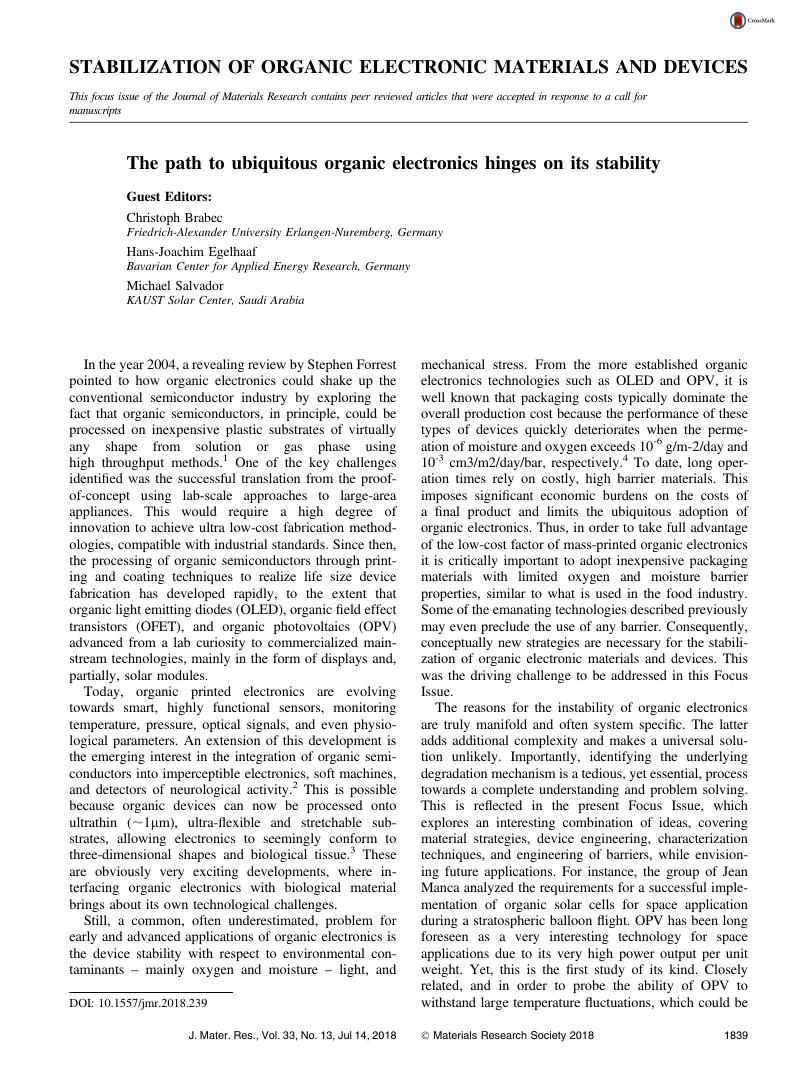Crossref Citations
This article has been cited by the following publications. This list is generated based on data provided by Crossref.
Morris, Joshua D.
and
Payne, Christine K.
2019.
Advances in materials for cellular applications (Review).
Biointerphases,
Vol. 14,
Issue. 1,
Fasano, Vito
Laurita, Romolo
Moffa, Maria
Gualandi, Chiara
Colombo, Vittorio
Gherardi, Matteo
Zussman, Eyal
Vasilyev, Gleb
Persano, Luana
Camposeo, Andrea
Focarete, Maria Letizia
and
Pisignano, Dario
2020.
Enhanced Electrospinning of Active Organic Fibers by Plasma Treatment on Conjugated Polymer Solutions.
ACS Applied Materials & Interfaces,
Vol. 12,
Issue. 23,
p.
26320.
Dou, Guangbin
and
Holmes, Andrew S.
2020.
System Integration for Plastic Electronics Using Room‐Temperature Ultrasonic Welding.
Advanced Engineering Materials,
Vol. 22,
Issue. 5,
Ko, Tae-Jun
Wang, Mengjing
Yoo, Changhyeon
Okogbue, Emmanuel
Islam, Md Ashraful
Li, Hao
Shawkat, Mashiyat Sumaiya
Han, Sang Sub
Oh, Kyu Hwan
and
Jung, Yeonwoong
2020.
Large-area 2D TMD layers for mechanically reconfigurable electronic devices.
Journal of Physics D: Applied Physics,
Vol. 53,
Issue. 31,
p.
313002.
Kukhta, Nadzeya A.
and
Luscombe, Christine K.
2022.
Gaining control over conjugated polymer morphology to improve the performance of organic electronics.
Chemical Communications,
Vol. 58,
Issue. 50,
p.
6982.
Wachsmuth, Josua
Distler, Andreas
Liu, Chao
Heumüller, Thomas
Liu, Yang
Aitchison, Catherine M.
Hauser, Alina
Rossier, Michael
Robitaille, Amélie
Llobel, Marc-Antoine
Morin, Pierre-Olivier
Thepaut, Anaïs
Arrive, Charline
McCulloch, Iain
Zhou, Yinhua
Brabec, Christoph J.
and
Egelhaaf, Hans-Joachim
2023.
Fully Printed and Industrially Scalable Semitransparent Organic Photovoltaic Modules: Navigating through Material and Processing Constraints.
Solar RRL,
Vol. 7,
Issue. 21,
Wachsmuth, Josua
Distler, Andreas
Deribew, Dargie
Salvador, Michael
Brabec, Christoph J.
and
Egelhaaf, Hans-Joachim
2023.
Overcoming Moisture‐Induced Degradation in Organic Solar Cells.
Advanced Engineering Materials,
Vol. 25,
Issue. 16,
Brixi, Samantha
Dindault, Chloé
King, Benjamin
Lamontagne, Halynne R.
Shuhendler, Adam J.
Swaraj, Sufal
and
Lessard, Benoît H.
2024.
Poly(2‐vinylpyridine) as an Additive for Enhancing N‐Type Organic Thin‐Film Transistor Stability.
Advanced Electronic Materials,
Vol. 10,
Issue. 2,
Chowdhury, Sanchari
Nieddu, Mattia
Patrian, Marta
Gutiérrez‐Armayor, David
Cavinato, Luca M.
Fuenzalida‐Werner, Juan Pablo
Lleó, Miquel García
Ligi, Simone
and
Costa, Rubén D.
2024.
Knocking the Stability of Solar Cells with Fluorescent Protein Donors upon Rationalizing Design, Integration, and Mechanism.
Advanced Materials Technologies,





